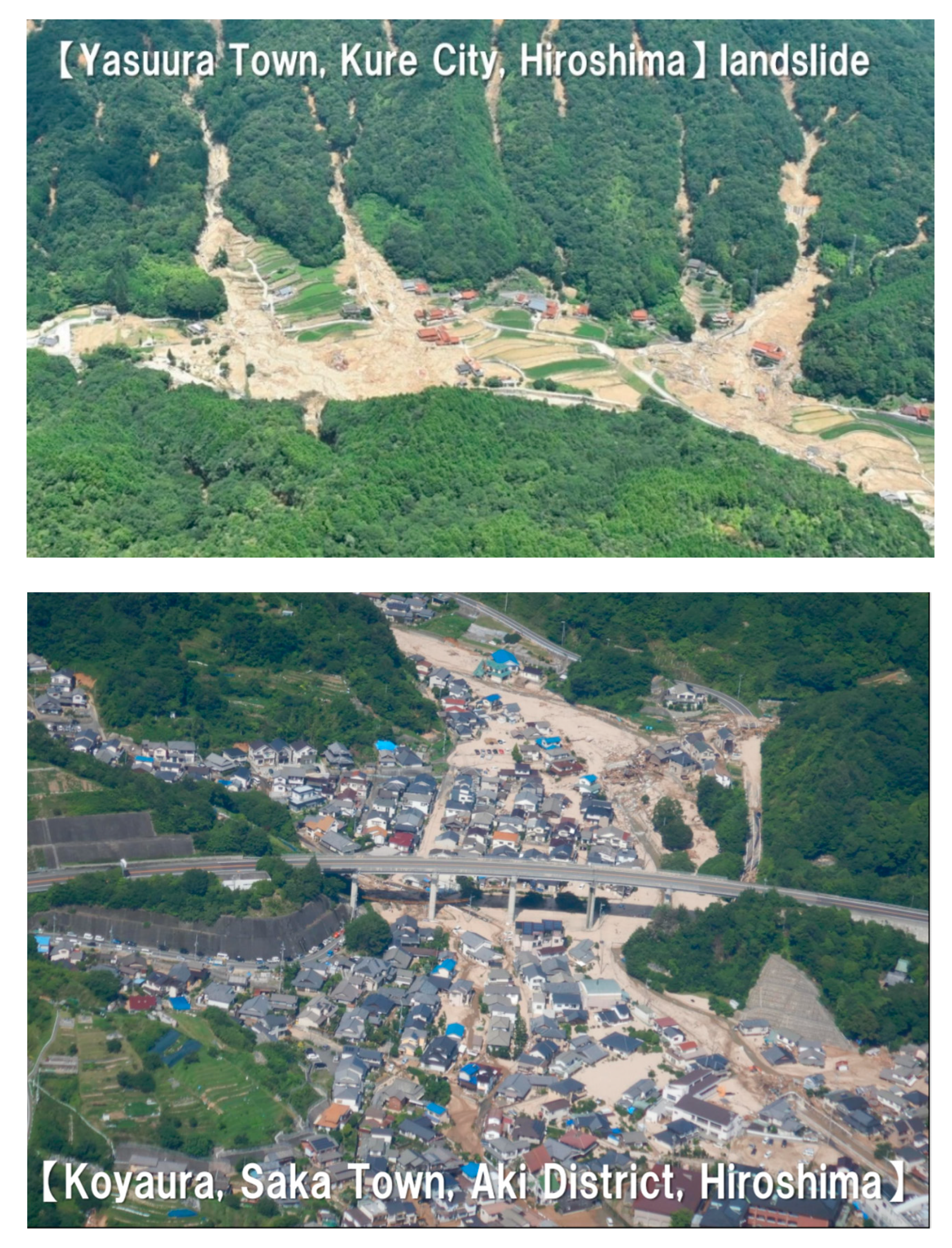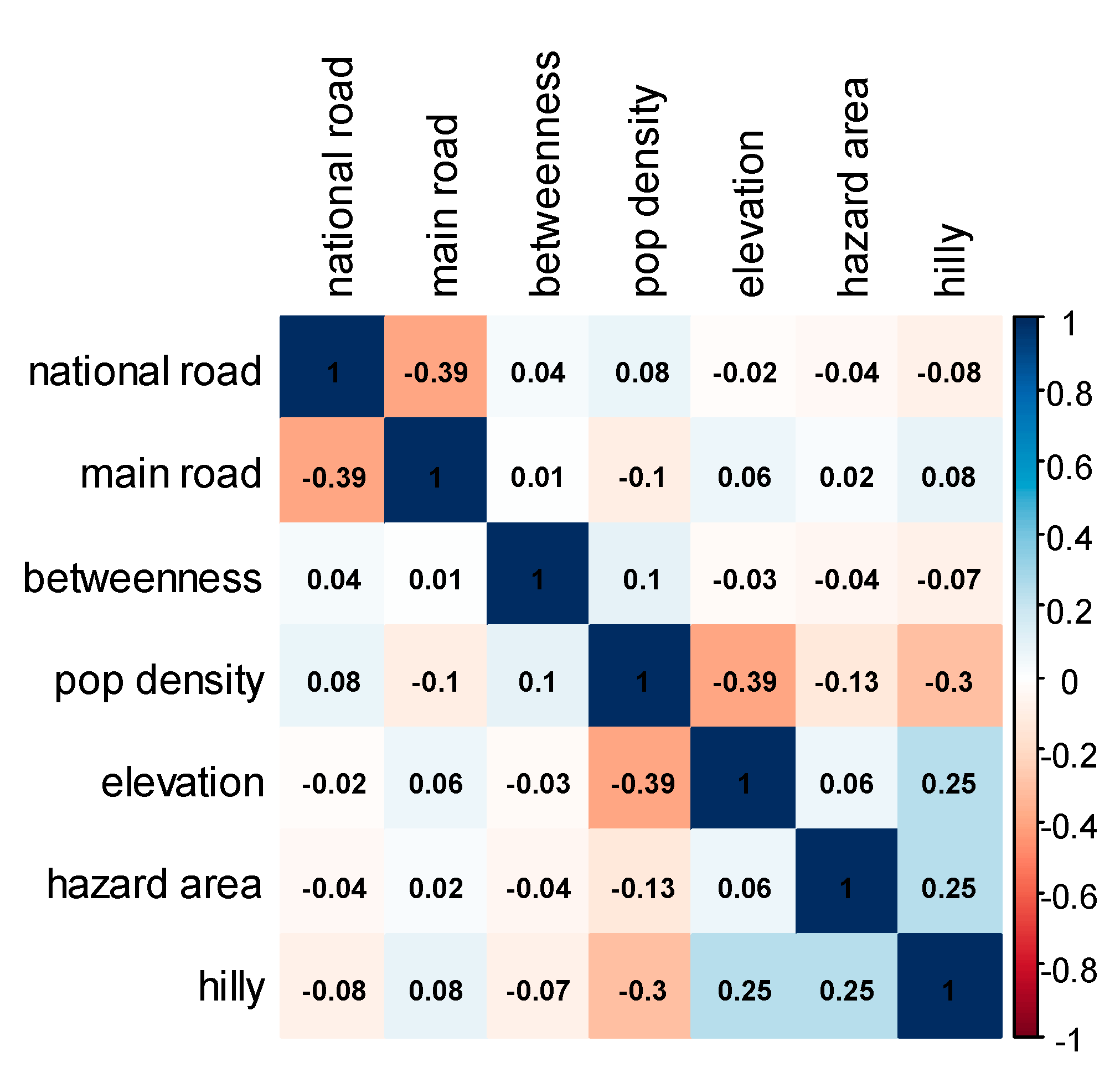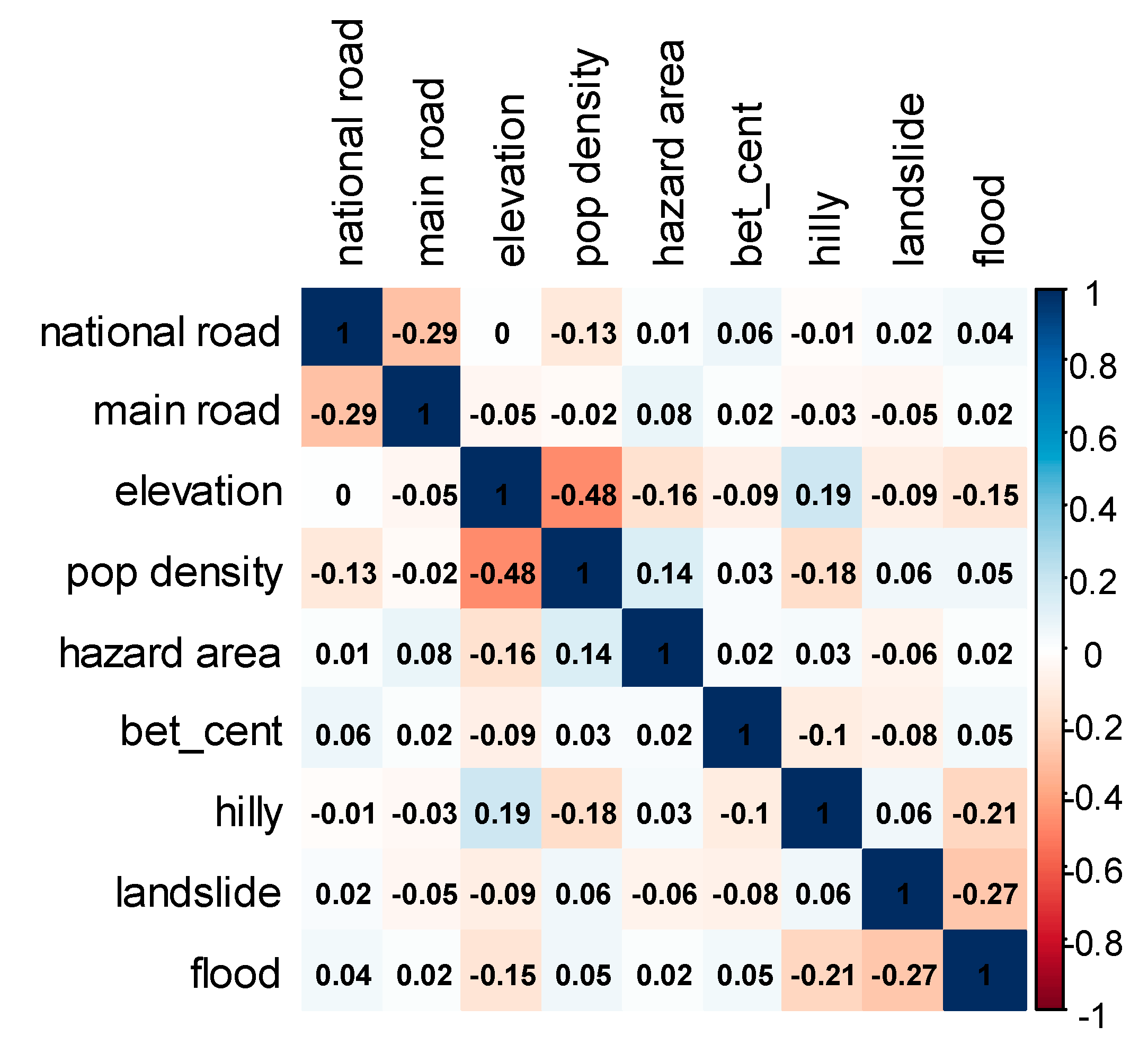Exploring Natural and Social Factors Affecting Road Disruption Patterns and the Duration of Recovery: A Case from Hiroshima, Japan
Abstract
1. Introduction
2. Literature Review
2.1. Road Network Vulnerability
2.2. Road Network Recovery
3. Research Framework
3.1. Study Area and Data
3.2. Probability of Road Link Disruption (Binary Probit Model)
3.3. Road Recovery Duration (Survival Model)
4. Results
4.1. Probability of Road Link Disruption (Binary Probit Model)
4.2. Road Recovery Duration (Survival Model)
5. Discussion
5.1. Probability of Road Link Disruption (Binary Probit Model)
5.2. Road Recovery Duration (Survival Model)
6. Conclusions
Author Contributions
Funding
Institutional Review Board Statement
Informed Consent Statement
Data Availability Statement
Conflicts of Interest
References
- Kaito, C.; Ito, A.; Kimura, S.; Kimura, Y.; Saito, Y.; Nakada, T. AR5 Synthesis Report: Climate Change 2014—IPCC. 2020, Volume 218. Available online: https://www.ipcc.ch/report/ar5/syr/ (accessed on 27 July 2022).
- Nicholson, A.; Du, Z.P. Degradable transportation systems: An integrated equilibrium model. Transp. Res. Part B Methodol. 1997, 31, 209–223. [Google Scholar] [CrossRef]
- Poser, K.; Dransch, D. Volunteered geographic information for disaster management with application to rapid flood damage estimation. Geomatica 2010, 64, 89–98. Available online: https://www.researchgate.net/publication/265619198_Volunteered_Geographic_Information_for_Disaster_Management_with_Application_to_Rapid_Flood_Damage_Estimation/figures?lo=1 (accessed on 27 July 2022).
- MLIT; Chugoku Regional Development Bureau. Keep in Mind: How We Responded to the Heavy Rain Disaster in July 2018. 2018. Available online: https://www.cgr.mlit.go.jp/photo/h3007gouu_kiroku/kioku_english.htm (accessed on 2 September 2022).
- Safitri, N.D.; Chikaraishi, M. Impact of transport network disruption on travel demand: A case study of the July 2018 heavy rain disaster in Japan. Asian Transp. Stud. 2022, 8, 100057. [Google Scholar] [CrossRef]
- Santos, J.R.; Safitri, N.D.; Safira, M.; Varghese, V.; Chikaraishi, M. Road network vulnerability and city-level characteristics: A nationwide comparative analysis of Japanese cities. Environ. Plan. B Urban Anal. City Sci. 2021, 48, 1091–1107. [Google Scholar] [CrossRef]
- United Nations News. Climate and Weather Related Disasters Surge Five-Fold over 50 Years, but Early Warnings Save Lives—Wmo Report | | Un News.). 1 September 2021. Available online: https://news.un.org/en/story/2021/09/1098662 (accessed on 27 June 2022).
- Resilience|UNDRR. 2009. Available online: https://www.undrr.org/terminology/resilience (accessed on 23 February 2022).
- Serulle, N.; Heaslip, K.; Brady, B.; Louisell, W.C.; Collura, J. Resiliency of transportation network of santo domingo, dominican republic: Case study. Transp. Res. Rec. 2011, 2234, 22–30. [Google Scholar] [CrossRef]
- Balal, E.; Valdez, G.; Miramontes, J.; Cheu, R.L. Comparative evaluation of measures for urban highway network resilience due to traffic incidents. Int. J. Transp. Sci. Technol. 2019, 8, 304–317. [Google Scholar] [CrossRef]
- Pan, S.; Yan, H.; He, J.; He, Z. Vulnerability and resilience of transportation systems: A recent literature review. Phys. A Stat. Mech. Its Appl. 2021, 581, 126235. [Google Scholar] [CrossRef]
- Zhang, X.; Miller-Hooks, E.; Denny, K. Assessing the role of network topology in transportation network resilience. J. Transp. Geogr. 2015, 46, 35–45. [Google Scholar] [CrossRef]
- Chen, H.; Zhang, L.; Ran, L. Vulnerability modeling and assessment in urban transit systems considering disaster chains: A weighted complex network approach. Int. J. Disaster Risk Reduct. 2021, 54, 102033. [Google Scholar] [CrossRef]
- Furno, A.; El Faouzi, N.E.; Sharma, R.; Cammarota, V.; Zimeo, E. A graph-based framework for real-time vulnerability assessment of road networks. In Proceedings of the 2018 IEEE International Conference on Smart Computing, Taormina, Italy, 18–20 June 2018; pp. 234–241. [Google Scholar] [CrossRef]
- Gao, L.; Liu, X.; Liu, Y.; Wang, P.; Deng, M.; Zhu, Q.; Li, H. Measuring road network topology vulnerability by Ricci curvature. Phys. A Stat. Mech. Its Appl. 2019, 527, 121071. [Google Scholar] [CrossRef]
- Hu, Z.; Wu, G.; Wu, H.; Zhang, L. Cross-sectoral preparedness and mitigation for networked typhoon disasters with cascading effects. Urban Clim. 2022, 42, 101140. [Google Scholar] [CrossRef]
- Tang, Y.; Huang, S. Assessing seismic vulnerability of urban road networks by a Bayesian network approach. Transp. Res. Part D Transp. Environ. 2019, 77, 390–402. [Google Scholar] [CrossRef]
- Zhang, H.; Yao, Y. An Integrative Vulnerability Evaluation Model to Urban Road Complex Network. Wirel. Pers. Commun. 2019, 107, 193–204. [Google Scholar] [CrossRef]
- Kermanshah, A.; Derrible, S. A geographical and multi-criteria vulnerability assessment of transportation networks against extreme earthquakes. Reliab. Eng. Syst. Saf. 2016, 153, 39–49. [Google Scholar] [CrossRef]
- Donovan, B.; Work, D.B. Empirically quantifying city-scale transportation system resilience to extreme events. Transp. Res. Part C Emerg. Technol. 2017, 79, 333–346. [Google Scholar] [CrossRef]
- Singh, P.; Sinha, V.S.P.; Vijhani, A.; Pahuja, N. Vulnerability assessment of urban road network from urban flood. Int. J. Disaster Risk Reduct. 2018, 28, 237–250. [Google Scholar] [CrossRef]
- Zhu, J.; Liu, K.; Wang, M.; Xu, W.; Liu, M.; Zheng, J. An empirical approach for developing functions for the vulnerability of roads to tropical cyclones. Transp. Res. Part D Transp. Environ. 2022, 102, 103136. [Google Scholar] [CrossRef]
- Bíl, M.; Vodák, R.; Kubeček, J.; Bílová, M.; Sedoník, J. Evaluating road network damage caused by natural disasters in the Czech Republic between 1997 and 2010. Transp. Res. Part A Policy Pract. 2015, 80, 90–103. [Google Scholar] [CrossRef]
- Rouhanizadeh, B.; Kermanshachi, S. Post-disaster reconstruction of transportation infrastructures: Lessons learned. Sustain. Cities Soc. 2020, 63, 102505. [Google Scholar] [CrossRef]
- Lacuarin, J.R.; Palmiano, H.S.O. The Role of Transportation Engineering in Disaster Management. 2020. Available online: http://ncts.upd.edu.ph/tssp/wp-content/uploads/2017/02/2010-02_lacuarin_final.pdf (accessed on 27 July 2022).
- Çelik, M. Network restoration and recovery in humanitarian operations: Framework, literature review, and research directions. Surv. Oper. Res. Manag. Sci. 2016, 21, 47–61. [Google Scholar] [CrossRef]
- Pourmohammadi, H. Urban Transportation Network Recovery Following a Catastrophic Event|Semantic Scholar. 2008. Available online: https://www.semanticscholar.org/paper/Urban-Transportation-Network-Recovery-Following-a-Pourmohammadi/f6b82365944a1c9554db60257504114c289c716b (accessed on 22 March 2022).
- Iloglu, S.; Albert, L.A. A maximal multiple coverage and network restoration problem for disaster recovery. Oper. Res. Perspect. 2020, 7, 100132. [Google Scholar] [CrossRef]
- Wang, C.Y.; Hu, S.R. A Study on Emergency Evacuation and Rescue Network Reconstruction for Natural Disasters with Multiclass Travel Behavior Constraints. J. East. Asia Soc. Transp. Stud. 2005, 6, 4269–4284. Available online: https://www.scopus.com/record/display.uri?eid=2-s2.0-84970897727&origin=inward&txGid=8de1d187343b7e8471296ff3c7ded6b2&featureToggles=FEATURE_NEW_DOC_DETAILS_EXPORT:1 (accessed on 22 March 2022).
- Zhao, T.; Zhang, Y. Transportation infrastructure restoration optimization considering mobility and accessibility in resilience measures. Transp. Res. Part C Emerg. Technol. 2020, 117, 102700. [Google Scholar] [CrossRef]
- Ajam, M.; Akbari, V.; Salman, F.S. Minimizing latency in post-disaster road clearance operations. Eur. J. Oper. Res. 2019, 277, 1098–1112. [Google Scholar] [CrossRef]
- Berktaş, N.; Kara, B.Y.; Karaşan, O.E. Solution methodologies for debris removal in disaster response. EURO J. Comput. Optim. 2016, 4, 403–445. [Google Scholar] [CrossRef]
- Sayarshad, H.R.; Du, X.; Gao, H.O. Dynamic post-disaster debris clearance problem with re-positioning of clearance equipment items under partially observable information. Transp. Res. Part B Methodol. 2020, 138, 352–372. [Google Scholar] [CrossRef]
- Gokalp, C.; Patil, P.N.; Boyles, S.D. Post-disaster recovery sequencing strategy for road networks. Transp. Res. Part B Methodol. 2021, 153, 228–245. [Google Scholar] [CrossRef]
- Rey, D.; Bar-Gera, H. Long-term scheduling for road network disaster recovery. Int. J. Disaster Risk Reduct. 2020, 42, 101353. [Google Scholar] [CrossRef]
- Tadano, K.; Maeno, Y.; Carnevali, L. Road repair sequencing for disaster victim evacuation. Adv. Intell. Syst. Comput. 2017, 528, 401–412. [Google Scholar] [CrossRef]
- Zhu, Y.; Ozbay, K.; Xie, K.; Yang, H. Using Big Data to Study Resilience of Taxi and Subway Trips for Hurricanes Sandy and Irene. Transp. Res. Rec. 2016, 2599, 70–80. [Google Scholar] [CrossRef]
- Joo S hyun Ogawa, Y.; Sekimoto, Y. Road-reconstruction after multi-locational flooding in multi-agent deep RL with the consideration of human mobility—Case study: Western Japan flooding in 2018. Int. J. Disaster Risk Reduct. 2022, 70, 102780. [Google Scholar] [CrossRef]
- About Hiroshima|Visit Hiroshima. 2019. Available online: https://visithiroshima.net/about/ (accessed on 23 February 2022).
- MLIT. Roads in Japan 2021. Road Bureau—Ministry of Land, Infrastructure, Transport and Tourism. 2021. Available online: https://www.mlit.go.jp/road/road_e/index_e.html (accessed on 2 September 2022).
- Freeman, L.C. A Set of Measures of Centrality Based on Betweenness. Sociometry 1997, 40, 35–41. [Google Scholar] [CrossRef]
- Kleinbaum, D.G.; Klein, M. Survival Analysis: A Self-Learning Text; Springer: New York, NY, USA, 2005; p. 590. [Google Scholar]
- Faruk, A. The comparison of proportional hazards and accelerated failure time models in analyzing the first birth interval survival data. J. Phys. Conf. Ser. 2018, 974, 012008. [Google Scholar] [CrossRef]
- Place and See. Hiroshima-Ken. 2022. Available online: https://placeandsee.com/wiki/hiroshima-ken (accessed on 2 March 2022).
- Wei, F.; Koc, E.; Li, N.; Soibelman, L.; Wei, D. A data-driven framework to evaluate the indirect economic impacts of transportation infrastructure disruptions. Int. J. Disaster Risk Reduct. 2022, 75, 102946. [Google Scholar] [CrossRef]





| Probability of Disruption Dataset | Road Recovery Dataset | |||
|---|---|---|---|---|
| Variables | Frequency | % | Frequency | % |
| Road Class | ||||
| National | 6295 | 25.08 | 285 | 18.85 |
| Main (Prefectural) | 7862 | 31.32 | 408 | 26.98 |
| Local (Prefectural) | 10,945 | 43.60 | 819 | 54.17 |
| Sediment Hazard Area | ||||
| In hazard area | 6672 | 26.58 | 808 | 53.44 |
| Not in hazard area | 18,430 | 73.43 | 704 | 46.56 |
| Terrain type | ||||
| Hilly area | 18,621 | 74.18 | 1427 | 94.38 |
| Others | 6481 | 25.82 | 85 | 5.62 |
| Cause of Disruption | ||||
| Landslide related | - | - | 683 | 45.17 |
| Flood related | - | - | 123 | 8.13 |
| Others | - | - | 706 | 46.70 |
| Mean | Standard Deviation | Mean | Standard Deviation | |
| Betweenness Centrality | 4.69 | 5.39 | 4.22 | 4.52 |
| Population Density (people per km2) | 975.69 | 1854.22 | 326.04 | 380.34 |
| Elevation (m) | 188.23 | 177.46 | 269.84 | 199.36 |
| Sample Size | 25,102 | 1512 | ||
| Covariate | Definition | Specification | Mean | Standard Error |
|---|---|---|---|---|
| Social factors | ||||
| r_nat | road classification dummy1 | 1 if road class is national road, 0 otherwise | 0.25 | 0.003 |
| r_main | road classification dummy2 | 1 if road class is main local road, 0 otherwise | 0.31 | 0.003 |
| bet_cent | centrality index | betweenness centrality measure of each link | 4.69 | 0.034 |
| pop_den | population density | population density where the link is located | 975.68 | 11.703 |
| Natural factors | ||||
| elev | elevation | average elevation of the area where the link is located, measured in meters | 188.20 | 1.120 |
| h_area | hazard area dummy | 1 if the link is located within the sediment hazard area, 0 otherwise | 0.27 | 0.003 |
| hilly | geologic location dummy | 1 if the link is located in a hilly area,0 otherwise | 0.74 | 0.003 |
| Covariate | Definition | Specification | Mean | Standard Error |
|---|---|---|---|---|
| Social factors | ||||
| r_nat | road classification dummy1 | 1 if road class is national road, 0 otherwise | 0.19 | 0.010 |
| r_main | road classification dummy2 | 1 if road class is main road, 0 otherwise | 0.27 | 0.011 |
| bet_cent | centrality index | betweenness centrality measure of each link | 4.22 | 0.116 |
| pop_den | population density | population density where the link is located | 326.04 | 9.735 |
| Natural factors | ||||
| elev | elevation | average elevation of the area where the link is located, measured in meters | 269.84 | 5.127 |
| h_area | hazard area dummy | 1 if the link is located within the sediment hazard area, 0 otherwise | 0.53 | 0.013 |
| landslide | cause of disruption dummy1 | 1 if the cause of link disruption is landslide related, 0 otherwise | 0.45 | 0.013 |
| flood | cause of disruption dummy2 | 1 if the cause of link disruption is flood related, 0 otherwise | 0.08 | 0.007 |
| hilly | geologic location dummy | 1 if the link is located in a hilly area,0 otherwise | 0.94 | 0.006 |
| Explanatory Variable | Full Model | Adjusted Model 1 | Adjusted Model 2 | |||
|---|---|---|---|---|---|---|
| Estimate | z Value | Estimate | z Value | Estimate | z Value | |
| intercept | −2.057 × 100 | −39.28 ** | −1.417 × 100 | −46.68 ** | −2.071 × 100 | −40.83 ** |
| r_nat | −2.208 × 10−1 | −6.29 ** | −2.361 × 10−1 | −6.99 ** | −2.223 × 10−1 | −6.34 ** |
| r_main | −2.496 × 10−1 | −7.99 ** | −2.376 × 10−1 | −7.86 ** | −2.504 × 10−1 | −8.02 ** |
| bet_cent | −2.822 × 10−3 | −0.99 | −5.395 × 10−3 | −1.97 * | - | - |
| pop_den | −1.487 × 10−4 | −8.39 ** | −2.020 × 10−4 | −11.12 ** | −1.489 × 10−4 | −8.41 ** |
| elev | 5.121 × 10−4 | 6.62 ** | 6.047 × 10−4 | 8.01 ** | 5.125 × 10−4 | 6.62 ** |
| h_area | 5.472 × 10−1 | 20.04 ** | - | - | 5.476 × 10−1 | 20.06 ** |
| hilly | 4.839 × 10−1 | 10.21 ** | - | - | 4.857 × 10−1 | 10.25 ** |
| AIC | 10,304 | 10,930 | 10,303 | |||
| Initial log-likelihood | −5738.20 | −5738.20 | −5738.20 | |||
| Final log-likelihood | −5144.04 | −5458.82 | −5144.55 | |||
| Sample Size | 25,102 | 25,102 | 25,102 | |||
| Survival Model | Initial Log-Likelihood | Final Log-Likelihood | AIC |
|---|---|---|---|
| Log Normal | −6222.3 | −6144.7 | 12,311.32 |
| Log Logistic | −6275.2 | −6190.7 | 12,403.31 |
| Exponential | −7663.7 | −7326.7 | 14,673.32 |
| Weibull | −6270.6 | −6173 | 12,368.05 |
| Explanatory Variable: | Full Model | Adjusted Model | ||
|---|---|---|---|---|
| Estimate | z Value | Estimate | z Value | |
| constant | 2.13 × 100 | 6.04 | 2.25 | 23.33 |
| r_nat | −2.32 × 10−1 | −1.33 | - | - |
| r_main | −4.56 × 10−1 | −3.00 | −0.39 | −2.72 |
| bet_cent | −2.88 × 10−2 | −2.02 | −0.03 | −2.16 |
| pop_den | −5.97 × 10−5 | −0.31 | - | - |
| elev | −6.02 × 10−5 | −0.16 | - | - |
| h_area | 2.64 × 10−2 | 0.20 | - | - |
| landslide | −7.57 × 10−2 | −0.56 | - | - |
| flood | −2.79 × 100 | −11.14 | −2.80 | −12.01 |
| hilly | 2.37 × 10−1 | 0.82 | - | - |
| Log (scale) | 9.06 × 10−1 | 49.61 | 0.91 | 49.67 |
| µ | 2.13 | 2.25 | ||
| AIC | 12,311.32 | 12,302.3 | ||
| Initial log-likelihood | −6222.3 | −6222.3 | ||
| Final log-likelihood | −6144.7 | −6146.2 | ||
| Sample Size | 1512 | 1512 | ||
Publisher’s Note: MDPI stays neutral with regard to jurisdictional claims in published maps and institutional affiliations. |
© 2022 by the authors. Licensee MDPI, Basel, Switzerland. This article is an open access article distributed under the terms and conditions of the Creative Commons Attribution (CC BY) license (https://creativecommons.org/licenses/by/4.0/).
Share and Cite
Sansano, R.; Chikaraishi, M. Exploring Natural and Social Factors Affecting Road Disruption Patterns and the Duration of Recovery: A Case from Hiroshima, Japan. Sustainability 2022, 14, 11634. https://doi.org/10.3390/su141811634
Sansano R, Chikaraishi M. Exploring Natural and Social Factors Affecting Road Disruption Patterns and the Duration of Recovery: A Case from Hiroshima, Japan. Sustainability. 2022; 14(18):11634. https://doi.org/10.3390/su141811634
Chicago/Turabian StyleSansano, Rodelia, and Makoto Chikaraishi. 2022. "Exploring Natural and Social Factors Affecting Road Disruption Patterns and the Duration of Recovery: A Case from Hiroshima, Japan" Sustainability 14, no. 18: 11634. https://doi.org/10.3390/su141811634
APA StyleSansano, R., & Chikaraishi, M. (2022). Exploring Natural and Social Factors Affecting Road Disruption Patterns and the Duration of Recovery: A Case from Hiroshima, Japan. Sustainability, 14(18), 11634. https://doi.org/10.3390/su141811634







